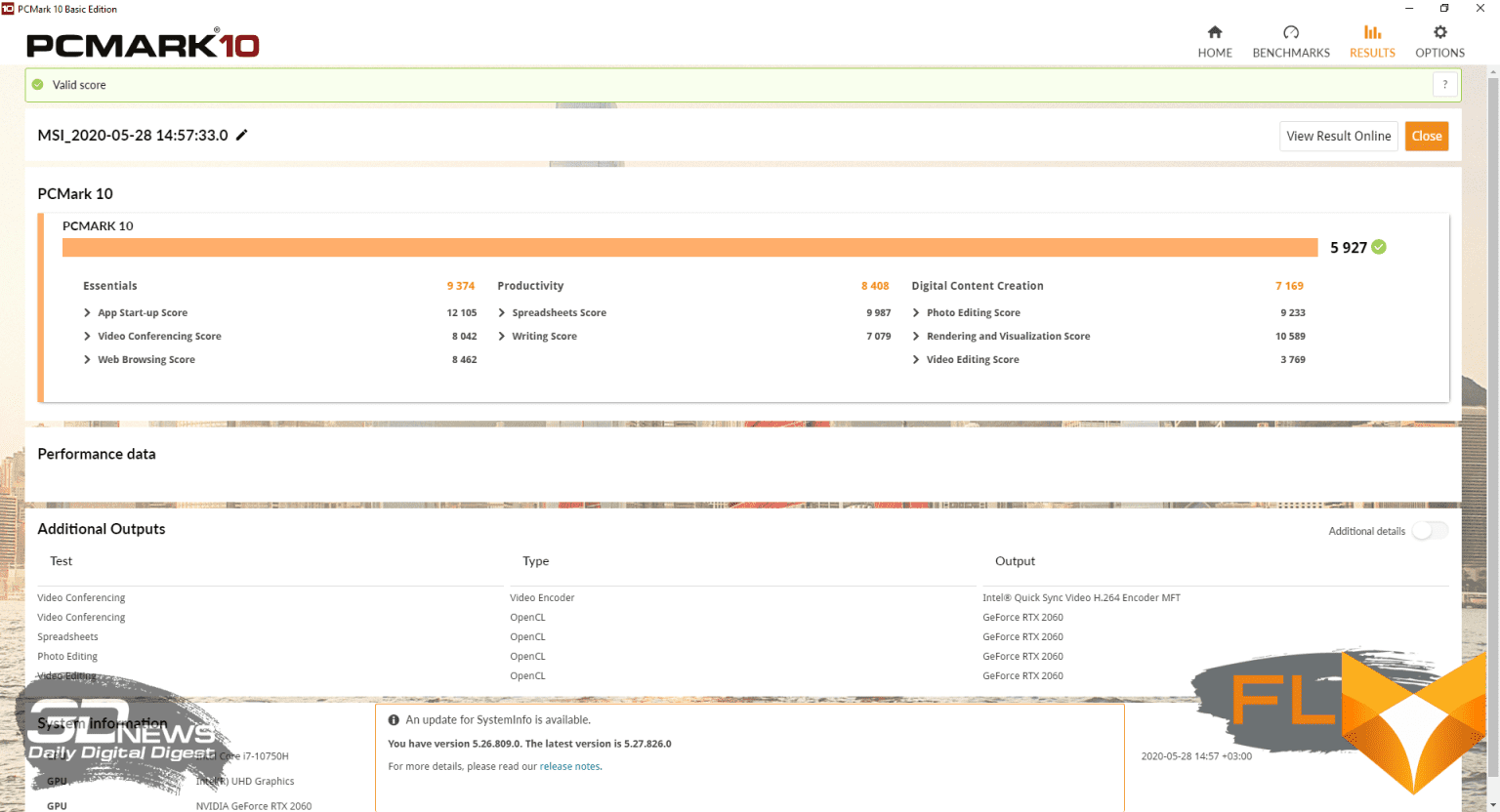


It looks like we are dealing with a trend: gaming laptops stop looking so … flashy and defiant. Now a powerful laptop is a strict-looking mobile computer that is not ashamed to be placed on the table in front of colleagues discussing important issues at a business meeting. This is later, in the evening after work, the spreadsheets in Excel will be closed, and Battlefield will appear on the screen. And the MSI GS66 Stealth can handle both with ease.
MSI GS66 Stealth
Specifications, equipment and software
There are quite a few modifications of the GS66 Stealth on the MSI global site. In all cases, we are talking about mobile PCs equipped with a 15.6-inch matrix with Full HD resolution. All the main characteristics of this series of notebooks are shown in the table below.
| MSI GS66 Stealth | |
| Primary display | 15.6″, 1920×1080, IPS, 240/300Hz |
| CPU | Intel Core i9-10980HK Intel Core i7-10750H |
| Video card | NVIDIA GeForce RTX 2080 SUPER Max-Q NVIDIA GeForce RTX 2070 SUPER Max-Q NVIDIA GeForce RTX 2070 Max-Q NVIDIA GeForce RTX 2060 |
| RAM | Up to 32GB DDR4-3200 (DDR4-2666 installed) |
| Install Drives | 1 × M.2 in SATA3/PCI Express x4 3.0 mode 1 × M.2 in PCI Express x4 3.0 mode |
| Optical drive | None |
| Interfaces | 1 × Thunderbolt 3 (shared with USB Type-C, DisplayPort, Power Delivery) 1 × USB 3.2 Gen2 Type-C 3 × USB 3.2 Gen2 Type -A 1 × 3.5mm mini-jack 1 × RJ-45 1 × HDMI |
| Built-in battery | 99.9 Wh |
| External power supply | 180/230W |
| Dimensions | 360 × 229 × 18 mm |
| Notebook weight | 2.1kg |
| Operating system | Windows 10 Home/Pro |
| Warranty | 2 years |
| Price | No data |

One of the younger and inexpensive, if these words are generally applicable to such a laptop, Stealth modifications, under the number 10SE-266RU, came to us for a test – this fact is definitely pleasing, since you are getting acquainted, perhaps, with the most running model in the series. The laptop has a 6-core Core i7-10750H and a 6 GB mobile version of the GeForce RTX 2060, as well as 16 GB of RAM and a 1 TB drive. All MSI GS66 Stealths come preloaded with Windows 10 – home or professional, to choose from. Unfortunately, at the time of this writing, there was no test modification on sale, so I cannot voice the real cost of this laptop. It is known that the model 10SFS-249RU with Core i9-10980HK, 32GB DDR4-2666, terabyte storage, 300Hz IPS-matrix and GeForce RTX 2070 in Max-Q design cost an average of $4,100 in May.
All GS66 Stealths are equipped with a Killer E3100 network controller with a maximum data transfer rate of 2.5 Gb / s. The Intel Wi-Fi 6 AX201 processor is responsible for wireless connection, which supports IEEE 802.11b/g/n/ac/ax standards with a frequency of 2.4 and 5 GHz and a maximum bandwidth of up to 2.4 Gbps. And this controller supports the Bluetooth 5.1 standard.
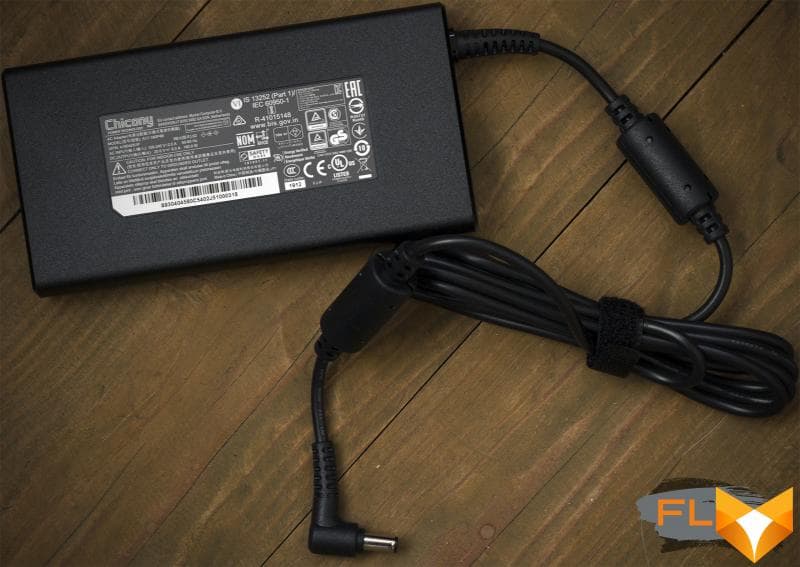
Included with the test laptop was a fairly compact external power supply manufactured by Chicony with a capacity of 180 watts. Kitchen scales showed that its mass is 502 grams.
Appearance and Input Devices
The manufacturer himself calls the color of the GS66 Stealth “true black”, and the design – “restrained”. And here, you know, you can’t argue with MSI. Perhaps the youth in the GS66 Stealth will not have enough pretentiousness, flashiness and riot of colors, but the older generation will definitely appreciate the appearance of the laptop. The logo on the lid does not glow, there is no backlighting along the edges of the case – modesty itself is in front of you, not otherwise.
The body of the GS66 Stealth is entirely made of metal and painted in matte black. Dust on the surface of the laptop is clearly visible, but fingerprints remain almost invisible.
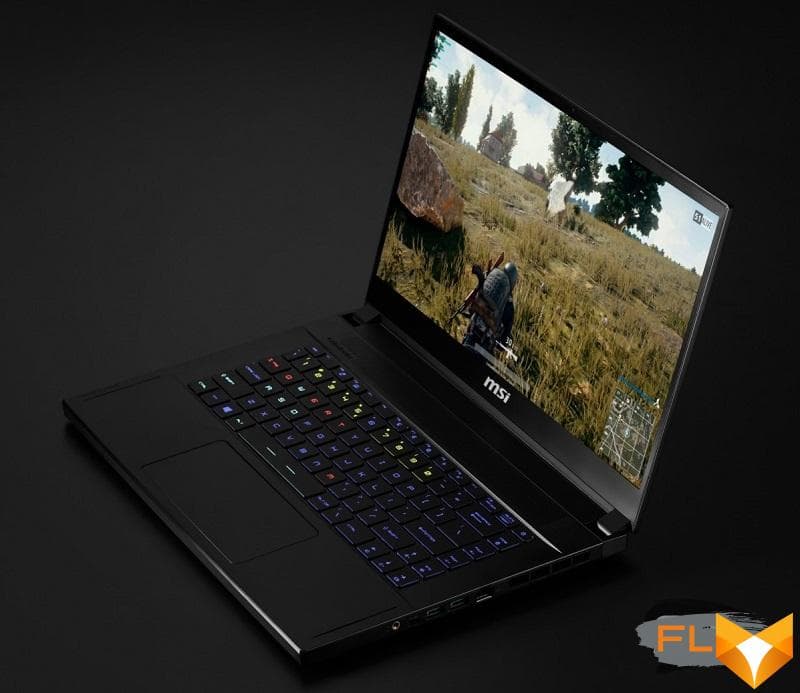
The laptop is compact by the standards of 15-inch gaming models. Firstly, its thickness does not exceed 18 mm, and its weight is 2.1 kg – if you wish, you can always take the computer with you. Secondly, the matrix has small frames on the sides, their thickness is 5 mm, due to which it was possible to reduce the depth and width of the case.
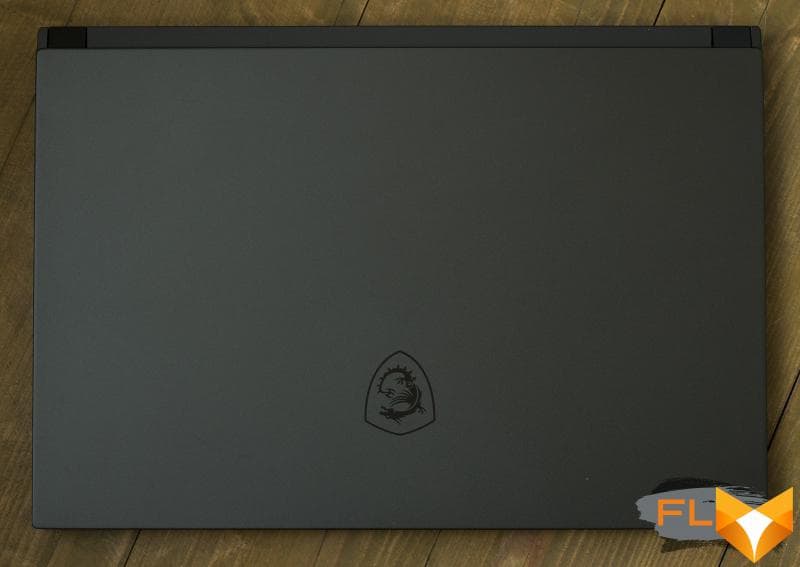
The laptop lid can be easily opened with one hand, the maximum opening angle is 180 degrees. The hinges are reliable and rigid. The lid flexes when you press it, but not much.
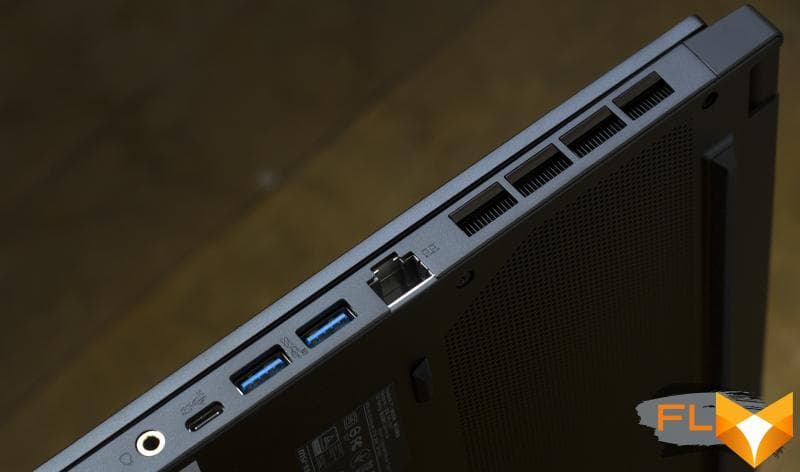
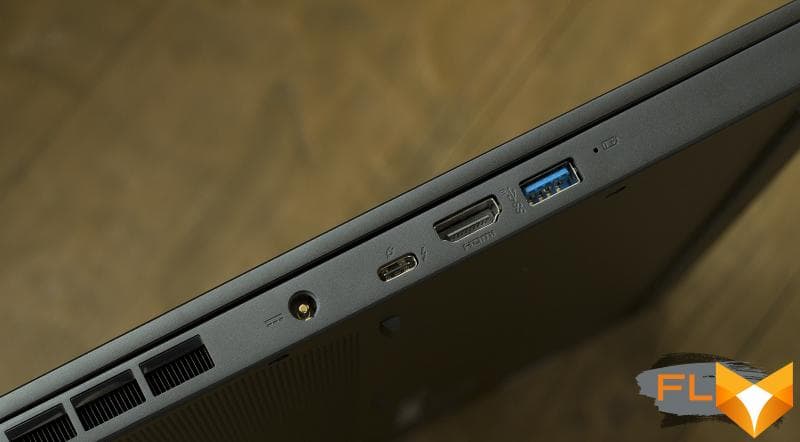
All connectors are located on the sides. On the left, you’ll find an external power supply port, Thunderbolt 3 (combined with USB 3.2 Gen2 Type-C and mini-DisplayPort, and also allows you to charge a laptop), HDMI-out and USB 3.2 Gen2 A-type. On the right there is a 3.5 mm mini-jack for connecting a headset, USB 3.2 Gen2 C-type, RJ-45 and two more full-sized USB 3.2 Gen 2 A-type. As you can see, up to two monitors can be connected to the laptop at the same time (including its own display – three, the manufacturer calls it Matrix Display 2 + 1), which turns the device into a powerful “traveling” workstation.
Indeed, the GS66 Stealth is positioned not only as a gaming system, but also as a laptop for the so-called creative professionals. In this case, for the complete happiness of the test model, there is not enough card reader. Otherwise, the functionality of the device is five plus.
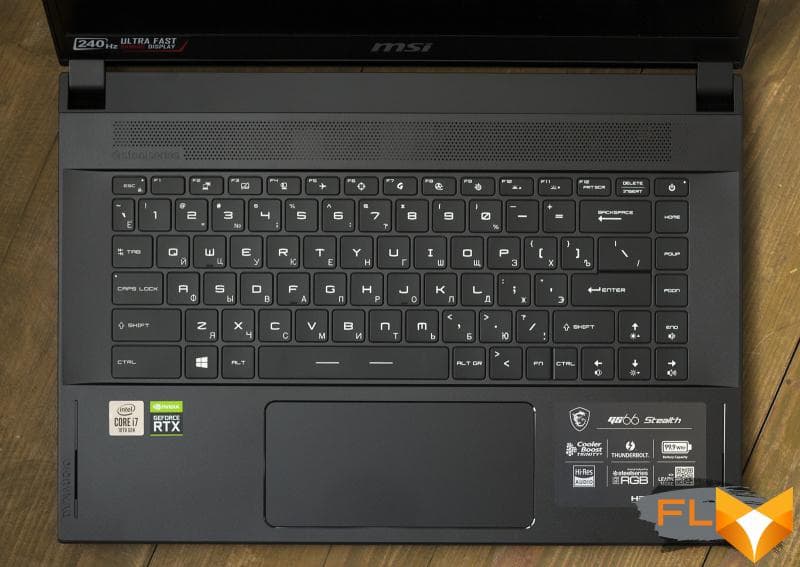
The keyboard and touchpad of the GS66 Stealth are very reminiscent of the input devices used in the MSI P65 Creator 9SF, further evidence that the device is suitable for content creators. The touchpad is large, sleek and incredibly comfortable as it measures 14cm wide.
The GS66 Stealth’s keyboard doesn’t exactly copy the one found in the P65 Creator 9SF, but it does in many ways. There is also no digital block, but MSI and SteelSeries engineers did not have to “flatten” some of the buttons. Perhaps, only the “Ё” and Fn keys were pretty bad – they turned out to be very small. Some will also be confused by the location of the function button on the right, and not on the left. You’ll have to get used to it, there’s nothing wrong with that. Another unusual thing: binding to Fn of the Print Screen function. But the arrow buttons are large and comfortable, the left Ctrl is the dream of any gamer, and Home, PgUp, PgDn and End are not lost, as, for example, in the ROG Zephyrus G14. In addition, there are no stupid permutations like a slash to the left of the Enter button, as some other manufacturers like to do – in general, using the GS66 Stealth keyboard is quite comfortable.
The travel of the buttons on MSI/SteelSeries keyboards is traditionally small, but tactilely clear. Pressing is almost silent. Each button has its own RGB LED. The lighting is customizable in SteelSeries Engine 3. Various visual effects are supported, including recognizing a musical melody or showing what is happening in a running game.
Even high-end gaming laptops in 2020 are still dominated by low-quality HD cameras. The GS66 Stealth is no exception in this regard, and its webcam is not suitable for normal streaming. But, according to the manufacturer, the camera also sees in the infrared range, which gives it advantages when using the Windows Hello system (face unlock). Yes, and with video calls to colleagues on Skype, she will cope quite well.
Internal design and upgrade options
The ability to independently change removable components is a big plus for the vast majority of MSI gaming laptops. The GS66 Stealth is relatively easy to disassemble. Relatively – because after dismantling the nine screws, you will have to sweat to pick up and carefully remove the bottom.
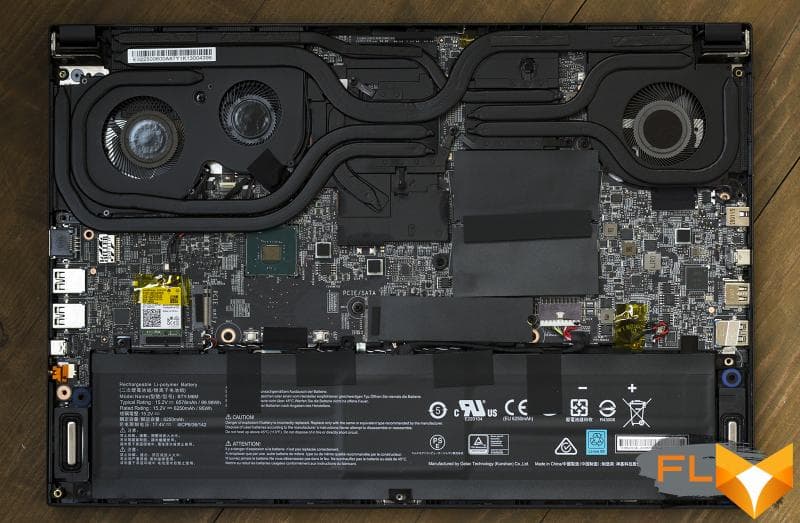
The Cooler Boost Trinity+ cooling system in the GS66 Stealth is conditionally separate. It consists of seven heat pipes and three fans. The cooler has a rather bizarre ornate design, I must admit. So, one heat pipe cooling the GPU is also designed to remove heat from the CPU power converter. And one heat pipe that cools the central processor additionally cools more elements of the power supply circuit of the graphics chip and memory.
The manufacturer paid more attention to the GPU – as many as five heat pipes were allocated to cool it and the VRM zone. The heat delivered with their help to a large radiator is dissipated by a pair of tangential-type fans. The central processor (in our case, the Core i7-10750H) is cooled by four shorter heat pipes and a radiator with fewer fins – this is clearly seen in the photo. Well, only one Carlson removes heat from the CPU.
The manufacturer claims that the Cooler Boost Trinity+ fans have the thinnest 0.1mm blades, which, according to MSI, create 15% more airflow compared to the previous generation cooler. However, we will study the efficiency of the GS66 Stealth cooling system in detail later.

In the meantime, I note that the test model is easy to upgrade in the future. Now the laptop has 16 GB of DDR4-2666 memory in the form of a pair of Samsung modules. Over time, you can double the amount of RAM. You can also install another SSD in pair with the Samsung MZVLB1T0HALR solid state drive – the second M.2 slot on the motherboard is empty.
Test Methodology
Since the laptop has a fairly powerful graphics, we tested in games using the maximum or close to those graphics quality settings. The full list of games and settings used for testing is given in the table below.
| Games | ||||
| Title | API | Graphic Quality | Full screen anti-aliasing | |
| Full HD | Ultra HD | |||
| Far Cry New Dawn, built-in benchmark | DirectX 11 | Maximum quality, HD textures included | TAA | TAA |
| The Witcher III: Wild Hunt, Novigrad and surroundings | Ultimate Quality Mode, NVIDIA HairWorks enabled, HBAO+ | AA | AA | |
| GTA V built-in benchmark (last scene) | Max. quality, advanced quality settings – on, image resolution scaling – off, 16 × AF | FXAA + 4 × MSAA | Without AA | |
| Dota 2 match replay | Maximum Quality | On | On | |
| Assassin’s Creed: Odyssey, built-in benchmark | Highest Mode | High | High | |
| Total War: Three Kingdoms, built-in benchmark | Max Mode | TAA | TAA | |
| World of Tanks enCore 1.0, benchmark | Ultra Mode | TSSAA HQ | TSSAA HQ | |
| Shadow of the Tomb Raider, built-in benchmark | DirectX 12 | Max. quality, DXR off | TAA | TAA |
| Battlefield V Last Tiger | Ultra mode, DXR off | TAA | TAA | |
| Metro Exodus, built-in benchmark | Ultra Mode | TAA | TAA | |
| Red Dead Redemption 2 built-in benchmark | Vulkan | Max. quality, advanced quality settings – off | TAA | TAA |
| Counter-Strike: Global Offensive | DirectX 9 | Max. quality | 8 × MSAA | 8 × MSAA |
Gaming performance was measured using the well-known FRAPS program. With its help, we get the rendering time of each frame. Then, using the FRAFS Bench Viewer utility, not only the average FPS is calculated, but also the 99th percentile. The use of the 99th percentile instead of the minimum frames per second is due to the desire to clean up the results from random bursts of performance that were provoked by reasons not directly related to the operation of the main components of the platform.
CPU and memory performance was measured using the following software:
- Corona 1.3. Testing rendering speed using the renderer of the same name. Measures the build speed of the standard BTR scene used to measure performance.
- WinRAR 5.40. Archive a folder of 11 GB with various data in RAR5 format and with the maximum degree of compression.
- Blender 2.80 RC1. Determination of the final rendering speed in one of the popular free packages for creating three-dimensional graphics. The duration of building the final model from Blender Cycles Benchmark rev4 is measured.
- x264 FHD Benchmark. H.264/AVC video transcoding speed testing.
- x265 HD Benchmark. H.265/HEVC video transcoding speed testing.
- CINEBENCH R15 and R20. Measuring the performance of photorealistic 3D rendering in the CINEMA 4D animation package, CPU test.
- Fritz 9 Chess Benchmarks. Testing the speed of a popular chess engine.
- JetStream 1.1 and WebXPRT 3 (browser – Google Chrome). Performance testing of web applications built using HTML5 and JavaScript algorithms.
- Adobe Premiere Pro 2019. Render project in 4K resolution.
- PCMark 10. A comprehensive benchmark that determines the level of performance of all laptop components.
Display testing is performed using the X-Rite i1Display Pro colorimeter and the HCFR application.
The battery life of the laptop was tested in two modes. The first load option – web surfing – involves alternately opening and closing the tabs of the Computeruniverse.ru and Unsplash.com sites with an interval of 30 seconds. For this test, the current version of the Google Chrome browser at the time of testing is used. In the second mode, video in .mkv format and Full HD resolution is played in the built-in player of Windows OS with the repeat function activated. In all cases, the same display brightness was set to 200 cd / m2, and the keyboard backlight (if any) and the sound were turned off. When playing video, the laptop worked in airplane mode.
In games and other applications, the results of the following laptops are considered:
| Test Participants | ||||||
| Model | Screen | Processor | RAM | Graphics | Drive | Battery |
| ASUS ROG Strix SCAR III (G531GW-AZ124T) | 15.6”, 1920 × 1080, IPS | Intel Core i9-9880H, 8/16 cores/threads, 2.3 (4.8) GHz, 45W | 32GB DDR4-2666 Dual Channel | NVIDIA GeForce RTX 2070 8GB GDDR6 | SSD, 1TB | No data |
| ASUS ROG Zephyrus M GU502GU | 15.6”, 1920 × 1080, IPS | Intel Core i7-9750H, 6/12 cores/threads, 2.6 (4.5) GHz, 45W | 16 GB DDR4-2666 Dual Channel | NVIDIA GeForce GTX 1660 Ti 6GB GDDR6 | SSD 512 GB | 76 Wh |
| ASUS TUF Gaming A15 FA506IV | 15.6”, 1920 × 1080, IPS | AMD Ryzen 7 4800H 8/16 Cores/Threads 2.9 (4.2GHz) 45W | 32 GB DDR4-3200 Dual Channel | NVIDIA GeForce RTX 2060 6GB GDDR6 | SSD, 1TB | 90 Wh |
| Lenovo Legion 7 | 15.6”, 1920 × 1080, IPS | Intel Core i9-10980HK, 8/16 cores/threads, 2.4 (5.3) GHz, 45W | 32 GB DDR4-3200 Dual Channel | NVIDIA GeForce RTX 2080 SUPER Max-Q 8GB GDDR6 | SSD, 2 TB, PCI Express x4 3.0 | 80 Wh |
| HP OMEN X 2S (15-dg0004ur) | 15.6”, 3840 × 2160, IPS | Intel Core i9-9880H, 8/16 cores/threads, 2.3 (4.8) GHz, 45W | 32 GB DDR4-3200 Dual Channel | NVIDIA GeForce RTX 2080 Max-Q 8GB GDDR6 | SSD, 2TB | 72 Wh |
| MSI GS66 Stealth | 15.6”, 1920 × 1080, IPS (IGZO) | Intel Core i7-10750H, 6/12 cores/threads, 2.6 (5.0) GHz, 45W | 16 GB DDR4-2666 Dual Channel | NVIDIA GeForce RTX 2060 6GB GDDR6 | SSD, 1TB | 99 Wh |
Display and sound
Some modifications of the GS66 Stealth are equipped with 300-Hz AUO B156HAN12.0 IPS-matrices equipped with an anti-reflective coating and supporting Full HD resolution. However, another part of MSI’s Stealth laptops is equipped with Sharp LQ156M1JW03 IPS panels, which use transistors based on indium gallium zinc oxide – IGZO. The test copy of the laptop just has such a screen. It also supports Full HD resolution, has a color gamut of 100% sRGB, but its vertical frequency is already 240 Hz.
| Gamma | Gamut | Color Temperature |
In short, the GS66 Stealth has a great display! Judge for yourself:
- Gamma 2.16 is just a tiny bit off the reference value of 2.2.
- Color temperature is mostly just above the 6500K reference, but grayscale stability is excellent.
- The color gamut is really close to 100% of the sRGB standard. The average deviation of DeltaE in grayscale is 1.21 with a maximum value of 2.22. The average error in the ColorChecker24 test was 1.68 with a maximum error of 2.34.
Therefore, the test model is quite possible to advise not only gamers, but also artists, architects, designers, and so on.
Perhaps, the brightness of Sharp LQ156M1JW03 is not enough for someone – the maximum white luminosity level was 272 cd/m2, and the minimum was 14 cd/m2. Partially, this indicator is corrected due to the presence of an anti-reflective coating. A real lack of brightness will be felt only when working with a laptop in the open in sunny weather.
At the same time, the display has a good (for laptops) contrast ratio – 1018: 1. Watching movies on the GS66 Stealth is very comfortable at any time of the day. The declared viewing angles – 178 degrees in both planes – correspond to reality, there are no noticeable distortions to the eye. The crystalline effect at the screen makes itself felt only on a black field, but it is still better than what conventional IPS matrices demonstrate. I did not find any visible light at the edges of the screen. Finally, the matrix used can be attributed to the category of Flicker-Free solutions in the entire working range of brightness.
The speakers in the GS66 Stealth are not just loud, but very, very, very loud. It’s been a while since I came across these laptops. At the same time, the sound quality can be described as above average. The speakers lack low frequencies, alas.
CPU and RAM efficiency
The six-core Core i7-10750H replaced the Core i7-9750H. The difference between these chips is only in two aspects – clock speed and memory controller. The more recent Comet Lake-H family chip has received support for DDR4-2933 RAM, although we see that the GS66 Stealth uses modules operating at an effective frequency of 2666 MHz. So here everything is at the mercy of the manufacturer. Something similar happens with clock frequencies. So, the base frequency of the Core i7-10750H and Core i7-9750H is the same – 2.6 GHz. However, the comet has a higher boost frequency: 5.0 GHz versus 4.5 GHz. When loading all the cores, the novelty can operate at a frequency of 4.2 GHz, and the 6-core of the previous generation – at 4 GHz. On paper, a difference of 200 MHz does not look menacing – so even without tests, we can safely say that these 6-core processors do not differ much from each other in terms of performance. However, as you well know, in many resource-intensive tasks, such indicators turn out to be unattainable – the TDP level is set too low for these chips. Yes, for a couple of minutes (maximum – up to 128 s) this restriction can be removed, but then, if the laptop’s CO and its power subsystem can cope with such a load, an inevitable reset of the clock frequency will still follow – a transition from the PL2 state to PL1. So the results shown in the table below should not be surprising – in complex tasks, such as Adobe Premier Pro, you will not see any 4-4.2 GHz when loading all the cores.
| Notebook cooling efficiency and CPU performance | |||||
| LinX 0.9.1 | Adobe Premiere Pro 2019 | ||||
| Balance | Extreme Performance | Balance | Extreme Performance | ||
| CPU frequency | Medium | 3.2 GHz | 3.2 GHz | 3.4 GHz | 3.4 GHz |
| CPU Temperature | Maximum | 96 °C | 97 °C | 97 °C | 97 °C |
| Medium | 90 °C | 91 °C | 90 °C | 91 °C | |
| Noise level | Maximum | 46.5 dBA | 46.6 dBA | 46.3 dBA | 46.5 dBA |
| CPU power consumption | Average | 53.5W | 54.6W | 54 W | 55.4W |
| Performance: Premiere Pro 2019 (less is better), LinX (more is better) | 213.3 GFLOPS | 219.5 GFLOPS | 1084 s | 1044 c | |
You should not be surprised at the discrepancy between the real power consumption and the TDP value. The test laptop has several modes of operation, I tested it with the “Balance” and “Extreme performance” settings. The laptop BIOS is calibrated so that the chip works at maximum efficiency, and therefore, in all modes, peak CPU temperatures reach 90+ degrees Celsius. The PL1 parameter, as you can see, “floats” from mode to mode within 50-65 W – the difference is small, but in both cases this value depends on many factors. The main one, of course, is the heating of the Core i7-10750H.
The laptop is noisy, but, as I said, it gets the most out of a 6-core processor with such power requirements and such a cooling system. For example, the average frequency of the Core i7-9750H in the ASUS ROG Zephyrus M GU502GU model in Adobe Premiere Pro 2019 was 3.2 GHz, and in the GS66 Stealth it was 3.4 GHz.
Below are the test results of various laptops. We see confirmation of the words said earlier: a laptop with a Core i7-10750H is far from always ahead of a system with a Core i7-9750H, because in practice the difference between these chips turns out to be small, plus various third-party factors interfere. Do not forget that not only the CPU is responsible for the performance of the laptop in processor-dependent programs, but also the RAM, as well as the main drive.
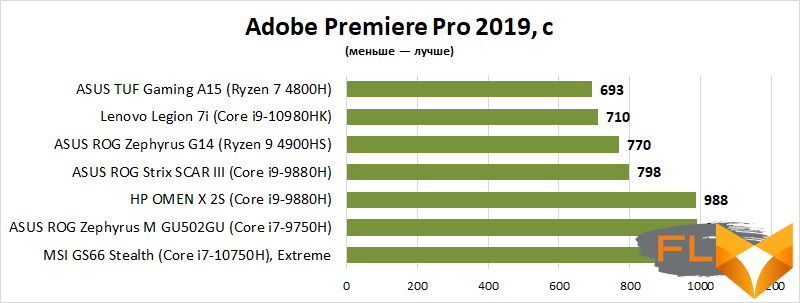

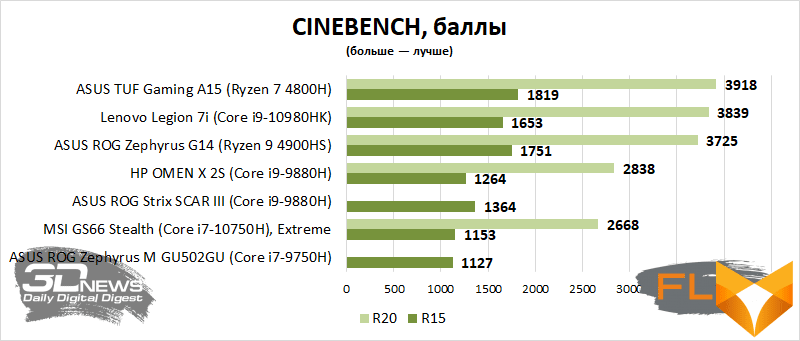
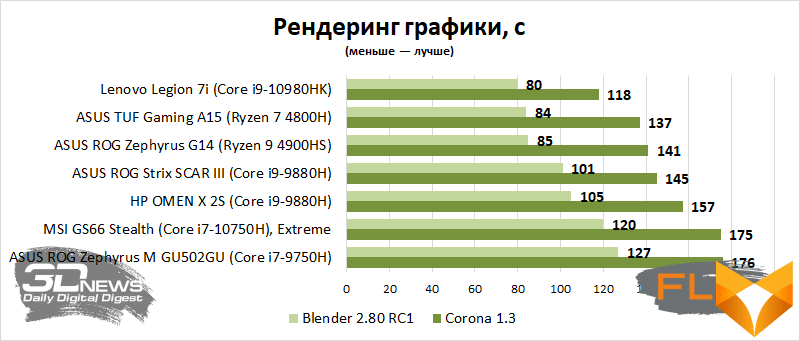

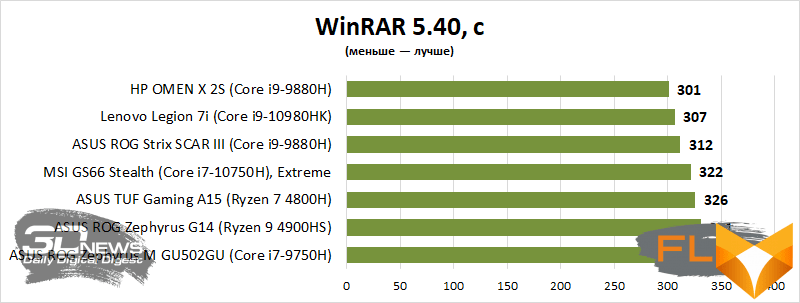

Below are the results of testing the laptop in the comprehensive PCMark 10 benchmark.
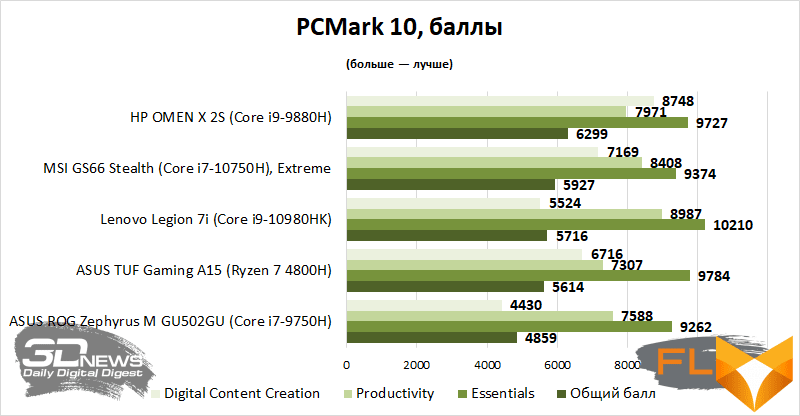
|
| Extreme Performance Mode |
Graphics efficiency
Mobile graphics like the GeForce RTX 2060 in 2020 are well suited for modern games in Full HD resolution. Therefore, the GS66 Stealth can safely be called a productive gaming system. If this level of performance is not enough for you, then you will have to fork out for a model with a GeForce RTX 2070 GPU or even cooler.
Balance Mode
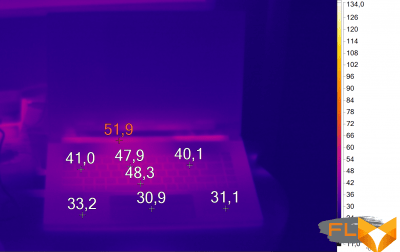 | 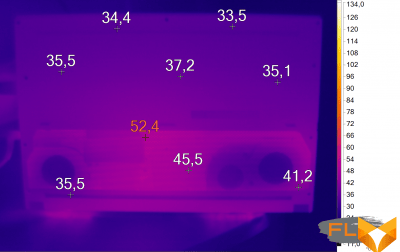 |
In The Witcher 3 in Balance mode, after two hours spent in the game, the average temperature of the hottest CPU core reaches 92 degrees Celsius, and the GPU reaches a maximum temperature of 75 degrees Celsius. We can see that the laptop’s cooler is really tuned for more efficient heat dissipation from the graphics. At the same time, the frequency of the graphics chip in games varied in the range from 1530 to 1770 MHz, but the average figure was 1542 MHz. The frequency of all cores of the Core i7-10750H is kept at 4.1 GHz.
Under load, the Stealth is quite noisy, but among the tested modern models there are noisier specimens. In games, a measuring device fixed at the level of the user’s head (~ 30 cm from the laptop) recorded a noise of 43.8 dBA.
Interestingly, switching from Balance mode to Extreme Performance mode had no effect – meaning that the GPU and CPU and the GS66 Stealth were running at their limits, limited by CO efficiency.
In general, the laptop demonstrates the level of performance predicted for a PC with GeForce RTX 2060 graphics – this is well shown by benchmarks. In Unigine Superposition, the test model scored 3557 points in 1080p Extreme mode.
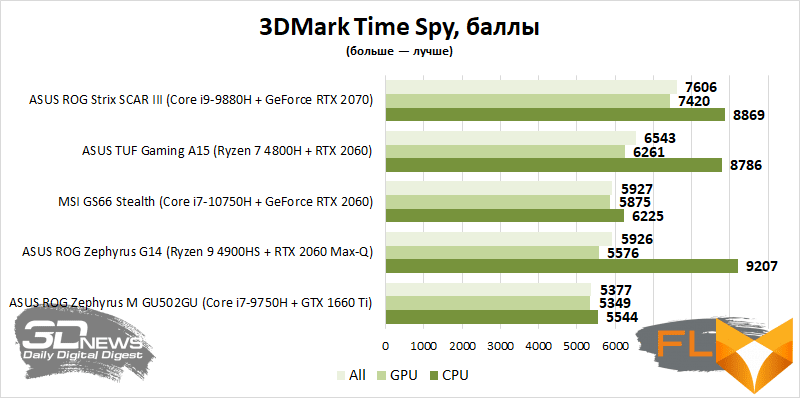
In almost all applications, except for Metro, there is quite a comfortable FPS. If you need a higher frame rate, then it will be enough to switch from the maximum graphics quality to very high or just high. Or independently delve into the settings of a particular game.
| MSI GS66 Stealth | ||
| Full HD | ||
| AVG FPS | 1 % min FPS | |
| Far Cry New Dawn, built-in benchmark | 82 | 61 |
| The Witcher III: Wild Hunt, Novigrad and surroundings | 78 | 57 |
| GTA V built-in benchmark (last scene) | 73 | 50 |
| Dota 2 match replay | 118 | 68 |
| Assassin’s Creed: Odyssey, built-in benchmark | 48 | 39 |
| World of Tanks enCore 1.0, benchmark | 131 | 94 |
| Shadow of the Tomb Raider, built-in benchmark | 76 | 51 |
| Battlefield V Last Tiger | 78 | 56 |
| Metro Exodus, built-in benchmark | 44 | 25 |
| Total War: Three Kingdoms, built-in benchmark | 55 | 45 |
| Red Dead Redemption 2 built-in benchmark | 45 | 37 |
| Counter-Strike: Global Offensive, Mirage map | 286 | 192 |
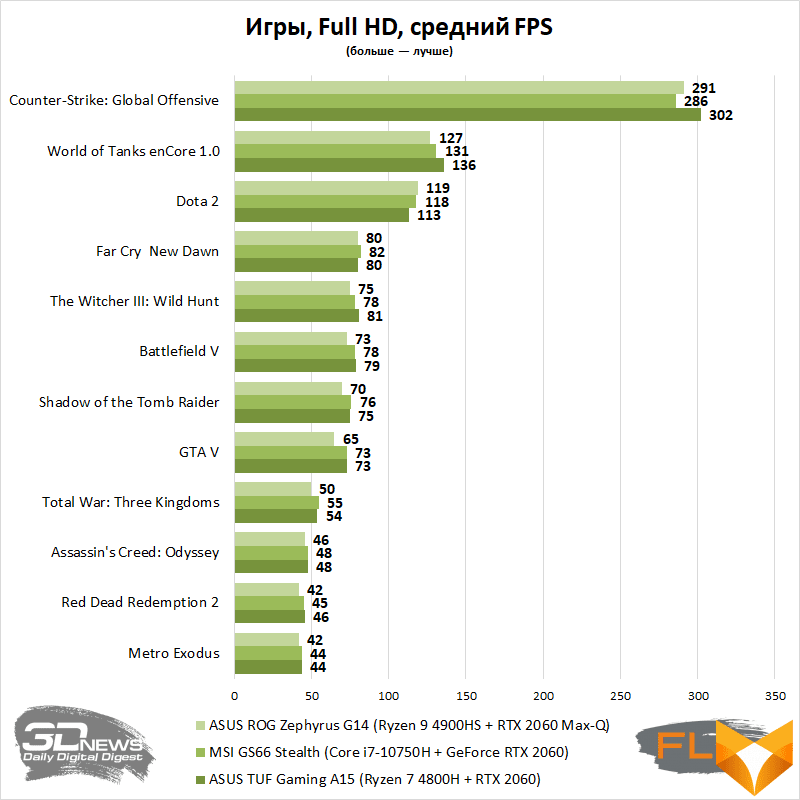
Disk subsystem performance
The Samsung MZVLB1T0HALR SSD used in MSI GS66 STEALTH belongs to the PM981 series. I am sure you are familiar with this drive – the Korean manufacturer retails it under the name 970 EVO. This means that the Samsung MZVLB1T0HALR uses 64-layer TLC 3D V-NAND, which is controlled by an eight-channel Samsung Phoenix controller. A detailed review of the Samsung 970 EVO can be found here.
The SSD in the GS66 Stealth is excellent – there is nothing to add here.
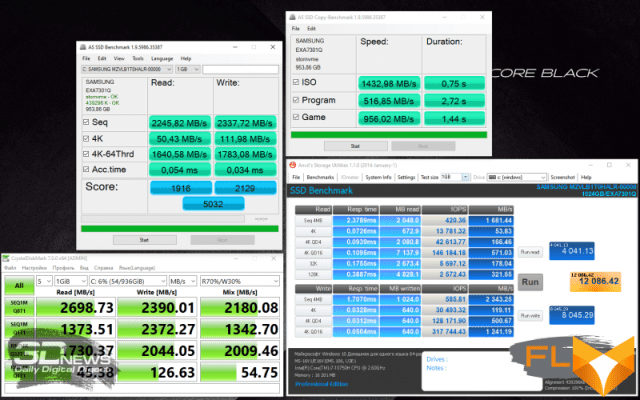
Offline work
The laptop is equipped with a 4-cell lithium-ion battery with a total charge of 99.9 Wh. It is not possible to install a larger battery due to the fact that devices with a larger battery do not allow you to take it with you into the cabin. With such a battery capacity, the GS66 Stealth, however, does not beat autonomy records. Nevertheless, the results obtained at a screen brightness of 200 cd/m2 can safely be considered good for a gaming model equipped with far from the most energy-efficient components.
| Autonomy, 200 cd/m2 | |
| Web | 6 hours 8 minutes |
| View video | 6 hours 5 minutes |
Conclusions
First of all, the GS66 Stealth is a very high-quality gaming laptop. Finding fault with the assembly, functionality and components used is pretty hard. The case is metal, and its strict design only makes the laptop more beautiful and practical. There are plenty of ports, while there is a modern Thunderbolt 3, which, in conjunction with HDMI2.0, makes it possible to connect up to two external monitors at the same time. The keyboard and touchpad are comfortable, it won’t take long to get used to the unusual arrangement of some buttons. The screen is excellent: it is quite suitable not only for gamers, but also for those who create content. Battery life is good, though we could have expected more from the 99.9 Wh battery. Finally, the laptop allows you to easily change components, and what cannot be replaced works as expected.
The disadvantages of the GS66 Stealth, perhaps, are only the high heating of the CPU and, as a result, the high noise level of the cooling system under load – in such conditions, the cooler fans constantly make themselves felt.
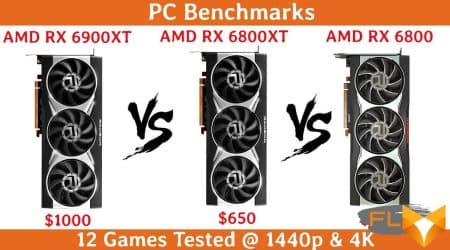

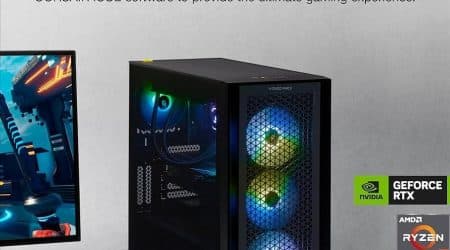
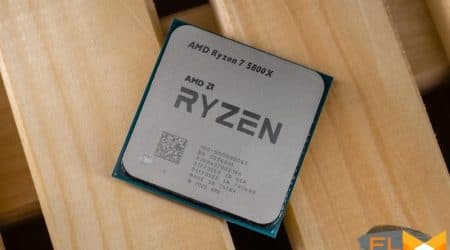
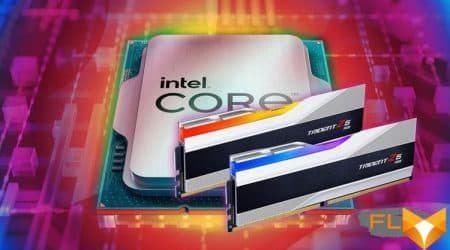

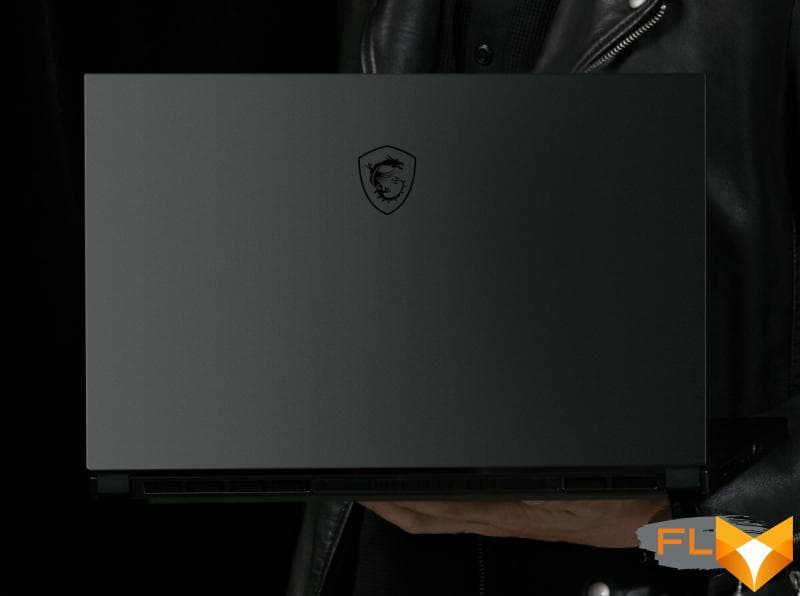

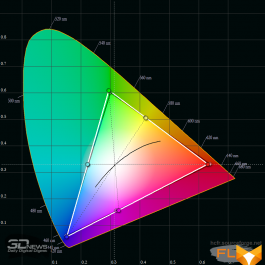
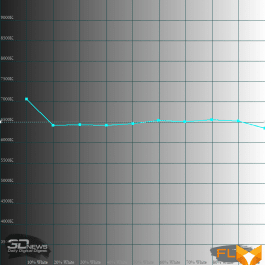

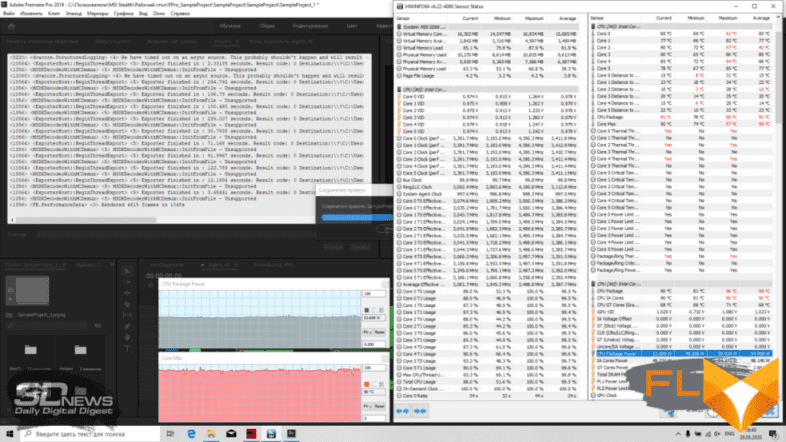
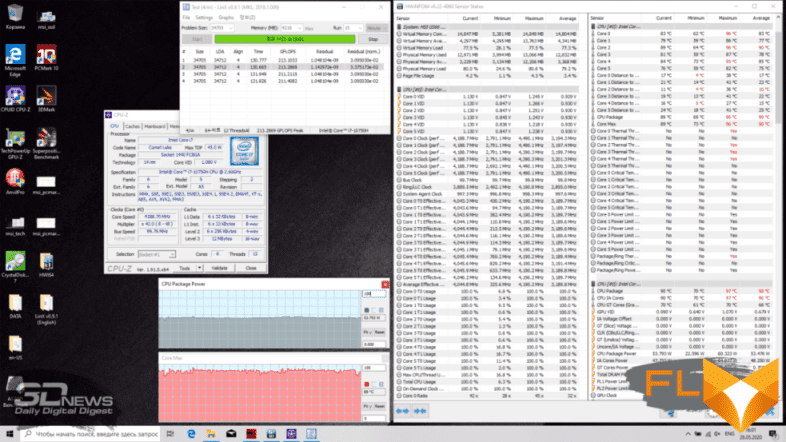
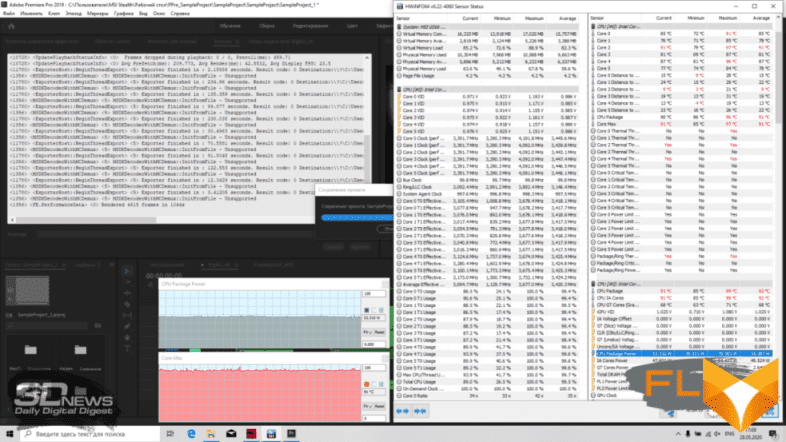
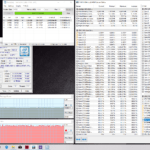
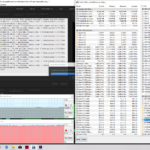


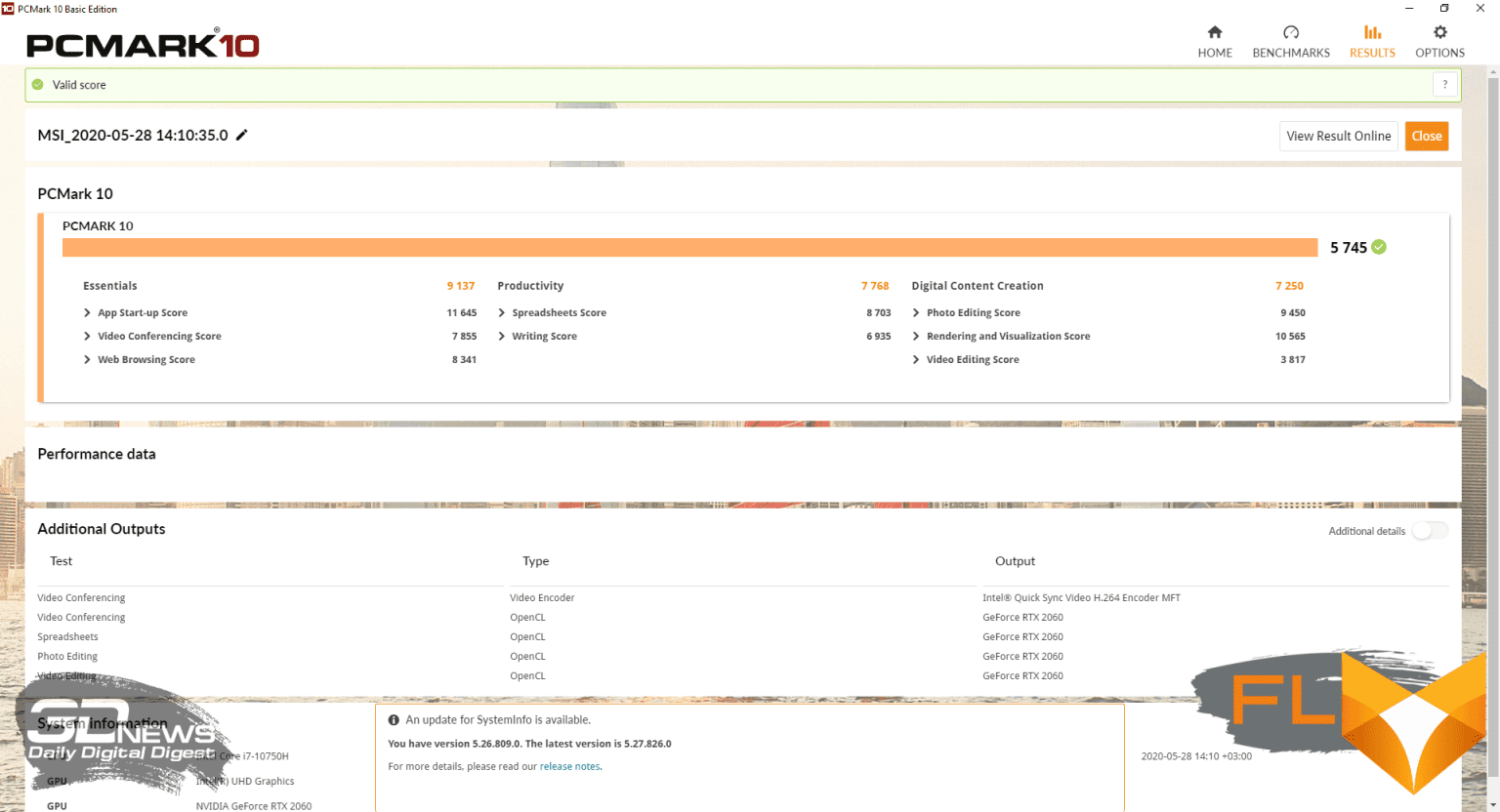 Balance Mode
Balance Mode